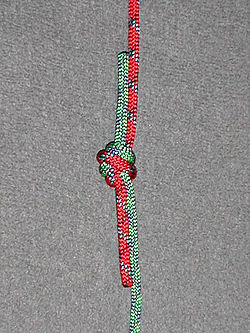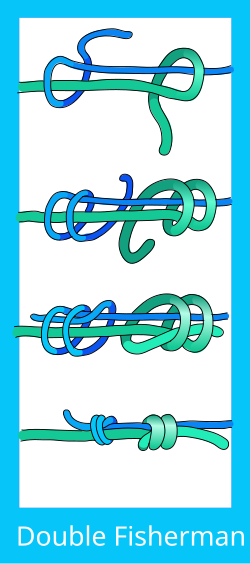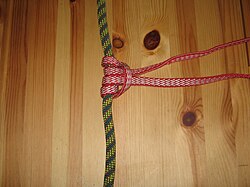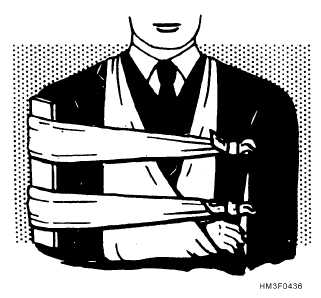Adventist Youth Honors Answer Book/Recreation/Abseiling
| Abseiling | ||
|---|---|---|
| Recreation South Pacific Division See also Abseiling - Advanced |
Skill Level Unknown |  |
| Year of Introduction: Unknown | ||
Safety
1. a. List and explain the safety rules
1. b. Explain the “dangers of falling” chart.
2. Explain the uses of the following knots:
a. Tape
| Ring Bend (Water Knot, Tape Knot) |
|---|

|
Use: The water knot (or tape knot)
is a knot frequently used in climbing for joining two ends of webbing
together, for instance when making a sling. The ends should be left at
least three inches long and the knot should be "set" by tightening it
with full body weight. The ends can be taped or lightly sewn to the
standing parts to help prevent them from creeping back into the knot.
Inspect the knot before each use.
How to tie:
|
b. Alpine butterfly
| Alpine butterfly |
|---|

|

Use: The Butterfly Loop has a high
breaking strength and is regarded by mountaineers as one of the
strongest knots to attach climbers to the middle of a rope, such that
they have room to move around even when the main rope goes tight, and
they can be supported in either direction from the main rope. The loop
is typically attached to a climbing harness by carabiner. It can also be
used to isolate a worn section of rope, where the knot is tied such
that the worn section is used for the center of the loop.
|
c. Figure of eight loop
| Figure Eight |
|---|

|
Use: This knot is ideal for keeping the end of a rope from running out of tackle or pulley.
How to tie:
|
d. Double fishermans
| Double Fisherman's Knot |
|---|

|
Use: Joining thin, stiff or slippery
lines, backing up critical knots such as the Figure-of-eight loop or
Figure-of-eight follow through.
Use the double fisherman's knot to tie together two ropes of unequal
sizes. This knot and the triple fisherman's knot are the variations used
most often in rock climbing, but other uses include search and rescue.
The primary use of this knot in rock climbing is to form high strength loops of cord for connecting pieces of the rock climber's protection system. It is favoured for being compact, and for arranging the line of force in a straight line through the knot. Another common use for this knot is to back up a critical knot, such as a harness tie-in knot or single-line rappel rigs. In this use, the running end is tied around the standing end of the rope, so that it cannot slip back through the knot.
How to tie:
|
e. Prussik
| Prusik knot |
|---|

|
f. Bowline
| Bowline |
|---|

|
Use: This knot doesn't jam or slip
when tied properly. It can be tied around a person's waist and used to
lift him, because the loop will not tighten under load. In sailing, the
bowline is used to tie a halyard to a sail head.
How to tie:
|
Setup
3. Draw the diagrams for the setting up of the following abseil descents:
a. Single rope technique
b. Canyoning setup
4. Know the ways to identify safe anchors in various circumstances, e.g. trees, boulders, bollards. Belaying
5. Explain the various verbal calls.
6. Explain the principle of belaying and the three methods used, and give the advantages and disadvantages of each method:
a. Body belay
b. Mechanical belay
c. Base belay
Care of Equipment
7. List the rules for care of ropes.
Adventist Youth Honors Answer Book/Knot/Care Of Rope8. Explain the difference between dynamic and static rope.
Dynamic rope is usually used for climbing activities where stretch to absorb the shock from a leader fall while on belay or climbing while roped with a team is expected. The dynamic function decreases deceleration injury and preserves the rope. After hard falls ropes may need to be retired from leader use.Static ropes are built with little or no stretch. They are best suited for caving, Abseiling and static safety tied ropes.
9. Know the right type of equipment needed for abseiling.
Personal Protective Equipment (PPE)A helmet will protect your head from falling rocks or other impacts. Here is what you should look for. Light weight Well ventilated Fits comfortably on your head and you can forget you’re even wearing soon after you put it on. Always wear a helmet.
A harness. A wide padded waist belt harness with loops for carrying gear is good. Tape harnesses are ample but not very comfortable. The harness must be fitted correctly...it should be fitted firmly above the hips around the waist first, then leg loops should be adjusted firmly. There should be no pressure spots, wedging or chaffing from quality harness.
Gloves. Novices such as school groups who do abseiling only while on an instructors safety belay will usually use gloves. Their hands are soft and easily blistered and as a beginner they tend to get rope burn by letting the rope loose then grasping it in fear or excitement. Choose gloves that fit your hand size, and not the one size fits all type garden variety. The perfect glove is a mitten type with padded palms and exposed fingers.
Footwear. Climbing shoes are not necessary but sturdy footwear is recommended.
Ropes...
Belay devices...
10. Know the best way to store your ropes, e.g. coiling and chaining.
Be aware that moisture, extreme temperatures Ultraviolet light, chemicals, abrasion and dirt can all damage ropes. Keeping them clean, dry and protected is mission critical to a full lifespan of the rope.Descenders
11 a. Know which descending device to use in different abseils.
11 b. Give reasons why you chose that device, e.g. on/off time, security, heat, versatility, etc.
First Aid
12. Know about how to treat a patient for the following injuries:
a. Sprains
Adventist Youth Honors Answer Book/First aid/Sprainsb. Concussion
Adventist Youth Honors Answer Book/First aid/Concussionc. Hypothermia
Hypothermia is caused by continued exposure to low or rapidly falling temperatures, cold moisture, snow, or ice. Those exposed to low temperatures for extended periods may suffer ill effects, even if they are well protected by clothing, because cold affects the body systems slowly, almost without notice. As the body cools, there are several stages of progressive discomfort and disability. The first symptom is shivering, which is an attempt to generate heat by repeated contractions of surface muscles. This is followed by a feeling of listlessness, indifference, and drowsiness. Unconsciousness can follow quickly. Shock becomes evident as the victim’s eyes assume a glassy stare, respiration becomes slow and shallow, and the pulse is weak or absent. As the body temperature drops even lower, peripheral circulation decreases and the extremities become susceptible to freezing. Finally, death results as the core temperature of the body approaches 80°F (27°C). The steps for treatment of hypothermia are as follows:- Carefully observe respiratory effort and heart beat; CPR may be required while the warming process is underway.
- Rewarm the victim as soon as possible. It may be necessary to treat other injuries before the victim can be moved to a warmer place. Severe bleeding must be controlled and fractures splinted over clothing before the victim is moved.
- Replace wet or frozen clothing and remove anything that constricts the victim’s arms, legs, or fingers, interfering with circulation.
- If the victim is inside a warm place and is conscious, the most effective method of warming is immersion in a tub of warm (100° to 105°F or 38° to 41°C) water. The water should be warm to the elbow - never hot. Observe closely for signs of respiratory failure and cardiac arrest (rewarming shock). Rewarming shock can be minimized by warming the body trunk before the limbs to prevent vasodilation in the extremities with subsequent shock due to blood volume shifts.
- If a tub is not available, apply external heat to both sides of the victim. Natural body heat (skin to skin) from two rescuers is the best method. This is called “buddy warming.” If this is not practical, use hot water bottles or an electric rewarming blanket. Do not place the blanket or bottles next to bare skin, however, and be careful to monitor the temperature of the artificial heat source, since the victim is very susceptible to burn injury. Because the victim is unable to generate adequate body heat, placement under a blanket or in a sleeping bag is not sufficient treatment.
- If the victim is conscious, give warm liquids to drink. Never give alcoholic beverages or allow the victim to smoke.
- Dry the victim thoroughly if water is used for rewarming.
- As soon as possible, transfer the victim to a definitive care facility. Be alert for the signs of respiratory and cardiac arrest during transfer, and keep the victim warm.
d. Broken bone
Splints An essential part of the first-aid treatment is immobilizing the injured part with splints so that the sharp ends of broken bones won’t move around and cause further damage to nerves, blood vessels, or vital organs. Splints are also used to immobilize severely injured joints or muscles and to prevent the enlargement of extensive wounds.Before you can use a splint, you need to have a general understanding of the use of splints. In an emergency, almost any firm object or material can be used as a splint. Such things as umbrellas, canes, tent pegs, sticks, oars, paddles, spars, wire, leather, boards, pillows, heavy clothing, corrugated cardboard, and folded newspapers can be used as splints. A fractured leg may sometimes be splinted by fastening it securely to the uninjured leg. Splints, whether ready-made or improvised, must meet the following requirements:
- Be light in weight, but still be strong and fairly rigid.
- Be long enough to reach the joints above and below the fracture.
- Be wide enough so the bandages used to hold them in place won’t pinch the injured part.
- Be well padded on the sides that touch the body. If they’re not properly padded, they won’t fit well and won’t adequately immobilize the injured part.
- To improvise the padding for a splint, use articles of clothing, bandages, cotton, blankets, or any other soft material.
- If the victim is wearing heavy clothes, apply the splint on the outside, allowing the clothing to serve as at least part of the required padding.
To secure the limb to the splint, belts, neckerchiefs, rope, or any suitable material may be used. If possible, tie the limb at two places above and two places below the break. Leave the treatment of other types of fractures, such as jaw, ribs, and spine, to medical personnel. Never try to move a person who might have a fractured spine or neck. Moving such a person could cause permanent paralysis. Don’t attempt to reset bones.
Forearm

Upper Arm

- NOTE
- Treatment of the fracture depends partly upon the location of the break.
If the fracture is in the middle of the upper arm, you can use one well-padded splint on the outside of the arm. The splint should extend from the shoulder to the elbow. Fasten the splinted arm firmly to the body and support the forearm in a narrow sling, as illustrated.
Another way of treating a fracture in the middle of the upper arm is to fasten two wide splints (or four narrow ones) about the arm and then support the forearm in a narrow sling. If you use a splint between the arm and the body, be very careful that it does not extend too far up into the armpit; a splint in this position can cause a dangerous compression of the blood vessels and nerves and may be extremely painful to the victim. If the fracture is at or near the elbow, the arm may be either bent or straight. No matter in what position you find the arm, DO NOT ATTEMPT TO STRAIGHTEN IT OR MOVE IT IN ANY WAY. Splint the arm as carefully as possible in the position in which you find it. This will prevent further nerve and blood vessel damage. The only exception to this is if there is no pulse on the other side of the fracture (relative to the heart), in which case gentle traction is applied and then the arm is splinted. Treat the victim for shock and get him under the care of a medical professional as soon as possible.
Kneecap

Ankle

e. Shock
Shock is a medical condition where the delivery of oxygen and nutrients is insufficient to meet the body's needs. The main carrier of oxygen and nutrients in the body is the blood, so anytime there is a loss of blood, there is a risk of shock. Shock is a life-threatening emergency.
Recovery position
- Immediate reassurance and comforting the victim if conscious.
- If alone, go for help. If not, send someone to go for help and someone stay with the victim.
- Ensure that the airway is clear and check for breathing. Place the victim in the recovery position if possible.
- Attempt to stop any obvious bleeding.
- Cover the victim with a blanket or jacket, but not too thick or it may cause a dangerous drop in blood pressure.
- Do not give a drink. Moisten lips if requested.
- Prepare for cardiopulmonary resuscitation (CPR).
- Give as much information as possible when the ambulance arrives.







No comments:
Post a Comment